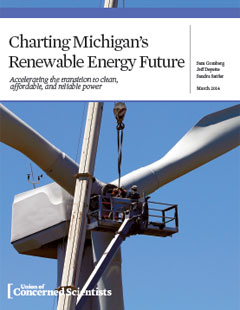Michigan has vast in-state renewable energy resources, yet currently relies heavily on its aging and inefficient coal fleet to generate electricity.
This overreliance on fossil fuels creates substantial air pollution and carbon emissions, and takes a significant toll on public health, the state's economy, and the climate.
The state took an important first step toward a cleaner energy future when it passed its renewable electricity standard (RES) in 2008, which requires Michigan utilities to ramp up renewable energy development to meet 10 percent of the state's electricity needs by 2015.
With the standard set to level off at the end of 2015, Michigan now has the opportunity to extend and strengthen the RES to continue the state's transition to a cleaner, more sustainable energy sector.
UCS analysis shows that in-state renewable energy resources can affordably and reliably generate 32.5 percent of Michigan's electricity by 2030 — and that ramping up renewables to this level would spur billions of dollars in investments, cut carbon emissions, and reduce the many risks of an overreliance on coal or natural gas.




